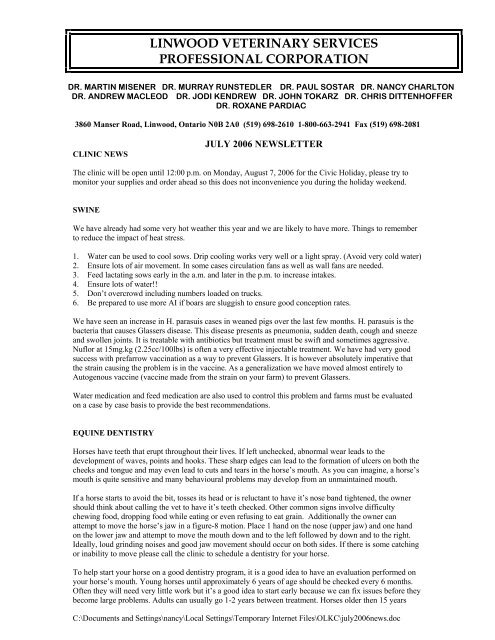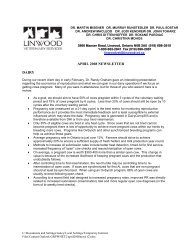July 2006 - Linwood Veterinary Services
July 2006 - Linwood Veterinary Services
July 2006 - Linwood Veterinary Services
Create successful ePaper yourself
Turn your PDF publications into a flip-book with our unique Google optimized e-Paper software.
LINWOOD VETERINARY SERVICES<br />
PROFESSIONAL CORPORATION<br />
DR. MARTIN MISENER DR. MURRAY RUNSTEDLER DR. PAUL SOSTAR DR. NANCY CHARLTON<br />
DR. ANDREW MACLEOD DR. JODI KENDREW DR. JOHN TOKARZ DR. CHRIS DITTENHOFFER<br />
DR. ROXANE PARDIAC<br />
3860 Manser Road, <strong>Linwood</strong>, Ontario N0B 2A0 (519) 698-2610 1-800-663-2941 Fax (519) 698-2081<br />
CLINIC NEWS<br />
JULY <strong>2006</strong> NEWSLETTER<br />
The clinic will be open until 12:00 p.m. on Monday, August 7, <strong>2006</strong> for the Civic Holiday, please try to<br />
monitor your supplies and order ahead so this does not inconvenience you during the holiday weekend.<br />
SWINE<br />
We have already had some very hot weather this year and we are likely to have more. Things to remember<br />
to reduce the impact of heat stress.<br />
1. Water can be used to cool sows. Drip cooling works very well or a light spray. (Avoid very cold water)<br />
2. Ensure lots of air movement. In some cases circulation fans as well as wall fans are needed.<br />
3. Feed lactating sows early in the a.m. and later in the p.m. to increase intakes.<br />
4. Ensure lots of water!!<br />
5. Don’t overcrowd including numbers loaded on trucks.<br />
6. Be prepared to use more AI if boars are sluggish to ensure good conception rates.<br />
We have seen an increase in H. parasuis cases in weaned pigs over the last few months. H. parasuis is the<br />
bacteria that causes Glassers disease. This disease presents as pneumonia, sudden death, cough and sneeze<br />
and swollen joints. It is treatable with antibiotics but treatment must be swift and sometimes aggressive.<br />
Nuflor at 15mg.kg (2.25cc/100lbs) is often a very effective injectable treatment. We have had very good<br />
success with prefarrow vaccination as a way to prevent Glassers. It is however absolutely imperative that<br />
the strain causing the problem is in the vaccine. As a generalization we have moved almost entirely to<br />
Autogenous vaccine (vaccine made from the strain on your farm) to prevent Glassers.<br />
Water medication and feed medication are also used to control this problem and farms must be evaluated<br />
on a case by case basis to provide the best recommendations.<br />
EQUINE DENTISTRY<br />
Horses have teeth that erupt throughout their lives. If left unchecked, abnormal wear leads to the<br />
development of waves, points and hooks. These sharp edges can lead to the formation of ulcers on both the<br />
cheeks and tongue and may even lead to cuts and tears in the horse’s mouth. As you can imagine, a horse’s<br />
mouth is quite sensitive and many behavioural problems may develop from an unmaintained mouth.<br />
If a horse starts to avoid the bit, tosses its head or is reluctant to have it’s nose band tightened, the owner<br />
should think about calling the vet to have it’s teeth checked. Other common signs involve difficulty<br />
chewing food, dropping food while eating or even refusing to eat grain. Additionally the owner can<br />
attempt to move the horse’s jaw in a figure-8 motion. Place 1 hand on the nose (upper jaw) and one hand<br />
on the lower jaw and attempt to move the mouth down and to the left followed by down and to the right.<br />
Ideally, loud grinding noises and good jaw movement should occur on both sides. If there is some catching<br />
or inability to move please call the clinic to schedule a dentistry for your horse.<br />
To help start your horse on a good dentistry program, it is a good idea to have an evaluation performed on<br />
your horse’s mouth. Young horses until approximately 6 years of age should be checked every 6 months.<br />
Often they will need very little work but it’s a good idea to start early because we can fix issues before they<br />
become large problems. Adults can usually go 1-2 years between treatment. Horses older then 15 years<br />
C:\Documents and Settings\nancy\Local Settings\Temporary Internet Files\OLKC\july<strong>2006</strong>news.doc
should be checked every 6 months. Through the proper maintenance of your horse’s mouth you will help<br />
prevent many behavioural problems as well as various health issues from developing.<br />
CALF MANAGEMENT<br />
For those of you feeding acidified milk, Dr. Neil Anderson from OMAF would like the opportunity to have<br />
his summer student visit your farm. The visit would take very little time and involve taking a milk sample<br />
from the feeding tube plus answering a short survey on the subject of feeding acidified milk. Please call the<br />
clinic and ask for Nancy if you are interested in participating in this small study.<br />
If you have tried the acidified milk feeding program and are frustrated with any aspect please give the clinic<br />
a call and ask to speak to Nancy. Many farmers have come up with “farmer friendly” ways of dealing with<br />
various hurdles. The health benefits from “free-access” feeding are tremendous and include less risk of<br />
stomach ulcers (those calves found dead or refuse to drink), multiple meals a day help keep the stomach at<br />
a healthier pH. Calves will scour but we do not have “empty gut” syndrome or “slug feeding” syndrome<br />
which can make the scour situation worse. Also, feeding waste milk is safer since the formic acid kills<br />
bacteria and preserves the milk. Recently I visited a veal farm and the calves on free-access were going to<br />
be weaned 7 to 10 days ahead of their barnmates who arrived on the same truck. A dairy farmer<br />
commented that getting calves to eat pelleted calf starter was not a problem even though they drank more<br />
milk. The calves were eating pelleted calf starter starting at three weeks of age.<br />
No matter how you raise or feed your calves, please ensure free choice water in this hot weather. Keep the<br />
air going through the hutches and try to place in the shade. Keep the air moving in the calf barns and watch<br />
carefully for summer time pneumonia.<br />
COW CALF<br />
With spring calving over with, now is a pleasant time to drive around and watch the calves on pasture. But<br />
as you are baling up those round bales, now may be the time to start thinking of the direction of your herd.<br />
Depending on who you talk to and when you talk, cull cow prices haven’t been that bad and calf prices are<br />
good. So, is this the fall to get mean and lean, to do that culling that you put off because the cows were<br />
worth nothing in the past? As the fall sales start to advertise, is this the time to consider purchasing<br />
pregnant heifers from genetics that can boost your herd? Just remember, buyer beware if your herd is not<br />
vaccinated or the herd you buy from is not vaccinated. If you have questions regarding the purchase of<br />
animals and health status, please call the clinic. The bottom line is, it is now time to cull those BSE heifers<br />
and cows that shouldn’t be in your herd and aren’t making you money.<br />
DAIRY<br />
A new service being offered by <strong>Linwood</strong> <strong>Veterinary</strong> <strong>Services</strong> is embryo transfer. Embryo transfer is an<br />
excellent way to propagate or introduce new genetics into your herd. Flushing top cows and transferring<br />
the embryos into heifers or cows allows a valuable cow to have multiple offspring in a single lactation. In<br />
this way you will have more high-quality replacement heifers and cows of poor or lower genetic potential<br />
will be more useful as recipients carrying these embryos.<br />
A donor cow is synchronized and treated to super-ovulate and release multiple eggs. The cow is<br />
inseminated and seven days later the embryos are removed and transferred to the recipients. Any additional<br />
eggs which cannot be transferred directly are frozen and can be implanted into recipients at a later date.<br />
A donor cow will give an average of 8 or 9 embryos per cow (though the range is from 0 to upwards of<br />
20!). Having a good response such as this makes embryo transfer a very reasonable and economical way to<br />
multiply exceptional animals within your herd. Incorporating embryo transfer into your herd is a very<br />
progressive way to improve your herd. Call Dr. Andrew MacLeod at <strong>Linwood</strong> <strong>Veterinary</strong> <strong>Services</strong> for<br />
more details.<br />
C:\Documents and Settings\nancy\Local Settings\Temporary Internet Files\OLKC\july<strong>2006</strong>news.doc



